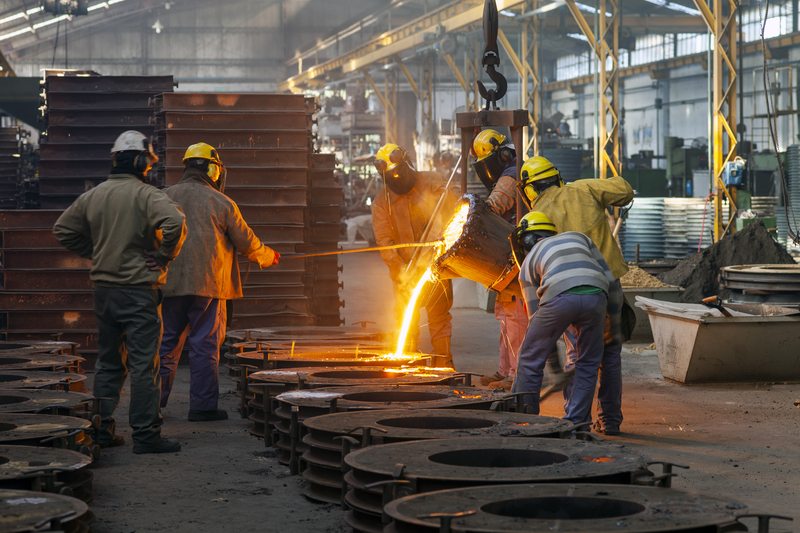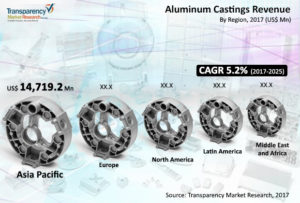Aluminum Castings Company for Dummies
Wiki Article
6 Simple Techniques For Aluminum Castings Company
Table of ContentsAbout Aluminum Castings CompanyMore About Aluminum Castings CompanyAluminum Castings Company Things To Know Before You Buy10 Easy Facts About Aluminum Castings Company ExplainedFascination About Aluminum Castings CompanyWhat Does Aluminum Castings Company Do?Aluminum Castings Company - The FactsThe Best Guide To Aluminum Castings Company
There are two key sorts of die casting used in the light weight aluminum casting market: warm chamber die spreading and cold chamber pass away casting. The primary difference between these techniques is how the molten metal is supplied to the mold and mildew. In warm chamber pass away spreading, commonly made use of for reduced melting factor steels, the fusion is straight connected to the maker, and a plunger compels the product with a gooseneck right into the die cavity.
Everything about Aluminum Castings Company
In these approaches, the mold is purposefully ruined or escaped in order to extract the completed light weight aluminum casting. Usual processes under the category of expendable mold and mildew casting include (financial investment casting),,, and financial investment casting. When manufacturing personalized aluminum parts utilizing expendable molds, manufacturers put molten aluminum or light weight aluminum alloys right into the mold and mildew, which is then busted apart to launch the solidified metal part.The is among the earliest and most utilized kinds of light weight aluminum spreading. It involves condensing specialized foundry sand, typically strengthened with clay or material, around an exactly crafted reusable pattern that identifies the shape and interior information of the ended up light weight aluminum item. The pattern system integrates risers and vents to manage the flow of liquified metal and to prevent casting problems such as contraction porosity.
The smart Trick of Aluminum Castings Company That Nobody is Discussing

This mold and mildew is then preheated prior to the putting of liquified light weight aluminum or aluminum alloy. As the steel loads the shell, it catches the elaborate details and fine surface finish of the mold. When cooled down, the ceramic is mechanically or chemically broken away, enabling the removal and splitting up of individual cast parts.
The Definitive Guide to Aluminum Castings Company
Long-term mold and mildew spreading utilizes recyclable steel molds and is optimal for automation with regular quality and much less waste. Expendable mold and mildew casting uses single-use molds, like sand or foam, providing layout flexibility and lower tooling costs for models or short runs. Pass away spreading is best for generating high volumes of light weight aluminum parts that need tight resistances, fine details, and smooth surfaces.The Toshiba Equipment DC-J Collection includes pass away casting makers appropriate for aluminum. Understood for their durable construction and high shot efficiency, these devices make sure efficient and accurate spreading (Sand Mold).

While light weight aluminum can be used in its pure kind, it is frequently alloyed with various other steels to improve its residential or commercial properties or the residential or commercial properties of the various other steels. Light weight aluminum alloys are categorized into eight series, phoned number from one to 8.
Little Known Facts About Aluminum Castings Company.
This alloying enhances the strength and hardness of aluminum but decreases its ductility and rust resistance. The 3000 series alloys are mainly alloyed with manganese.The 4000 collection alloys are alloyed with silicon, which reduces the melting factor and enhances fluidity. This makes it a prominent option for spreading, as it is very easy to form in its molten state.
Examine This Report on Aluminum Castings Company
This series is categorized as a high-strength alloy, particularly fit for sheet and plate applications because of its superb weldability. Its resistance to rust from acids and alkalis makes it excellent for read more usage in rough and aggressive environments (Aluminum Castings). The 6000 collection alloys are alloyed with both magnesium and silicon, supplying an equilibrium of strength, mechanical properties, and rust resistanceProcessing the 6000 series calls for specialized and advanced tools, which can be complex and costly. This series is recognized for its excellent corrosion and oxidation resistance, as well as its convenience of coating, therapy, and workability. The 7000 series aluminum alloys are the greatest and most resilient amongst light weight aluminum types, with stamina equivalent to around two-thirds of industrial-grade A3 steel.
Excitement About Aluminum Castings Company
Zinc is the key alloying element in the 7000 collection, improving the hardness of the light weight aluminum, although zinc's firmness is similar to that of light weight aluminum on the Mohs range. The 8000 series light weight aluminum alloys are primarily alloyed with tin, together with small amounts of copper and nickel (Sand Foundry). While these alloys supply lower toughness compared to other series, they stand out in machinability and wear resistanceAluminum cast heatsinks are electrically conductive, permitting them to be based successfully. They are typically cast with integrated functions that minimize the demand for secondary operations, such as extra machining or setting up, causing further cost financial savings. Aluminum spreading is regularly used to produce brackets for both sturdy industrial equipment and house appliances.
About Aluminum Castings Company
The single-piece building and construction of aluminum braces improves their stamina and resilience, decreasing the likelihood of failure. If openings are required, they can be consisted of straight in the spreading mold, reducing the need for post-production completing (https://giphy.com/channel/alumnmcstngs). Makers have increasingly taken on aluminum spreading for golf tools as a result of its sturdiness, security, and flexibility in shapingReport this wiki page